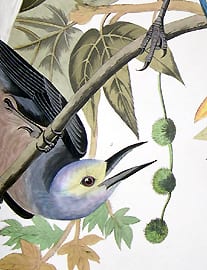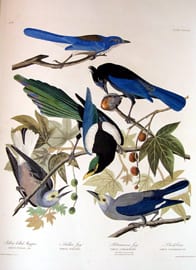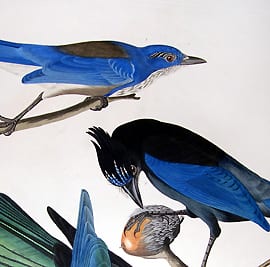
- This event has passed.
John James Audubon’s Birds of America, Vol. IV
February 14, 2005 - December 3, 2005

Designed by Art 275: Jessica Davidson, Jessica Miely, Emily Shutt.
John James Audubon’s Birds of America, an unusual nineteenth century work in four volumes, is an important part of Lehigh University’s extensive rare books collection. On view is Volume IV, demonstrating how Audubon’s hybrid of science and art, ornithology and printmaking, makes him one of the most celebrated scientific naturalists of all time.
John James Audubon was born on April 26, 1785 in Las Cayes, Haiti, the illegitimate son of a Frenchman and his mistress, a native of Las Cayes. After a childhood spent in France, Audubon was sent to his father’s estate in Norristown, Pennsylvania, where he became skilled at hunting and drawing birds. Ornithology, the study of birds, became a passion for Audubon, and he created an impressive portfolio of drawings.
As a young man, Audubon set off on an epic quest to pursue his dream of painting and documenting all of the American birds. Audubon aspired to draw the birds life-sized and in full color. This endeavor was without precedent in the history of American Ornithology. Audubon used his skills to shoot the birds, wire them, and prop them into life-like positions as models for his paintings.
Failing to find an engraver in America who would take on the large task of creating a multi-volume work, Audubon sailed to Liverpool, England in May of 1826 with his massive portfolio. Upon displaying some of his paintings there, Audubon received much praise and attention. A subscription book was made for The Birds of America, an invaluable method for books with limited market potential. The plates were in sets of five, which subscribers would then bind themselves once they had a complete set.
Audubon changed his engraver in 1827
from William Lizars to Robert Havell in London. Audubon was able to keep a close watch over Havell’s work and together they succeeded in printing all 435 plates by 1838. The final Double Elephant Tolio of The Birds of America contained 497 species in four volumes. Today there are only 175 to 200 complete copies of the set in the world, one belonging to Lehigh University.
Plate 362:The Corvidae Family includes the Yellow-billed Magpie, Stellar’s Jay, the Ultramarine Jay, and Clarke’s Crow, among others. The Yellow-billed Magpie, or Pica nuttallii, is a long tailed bird that is found in California. This mostly black and white bird is characterized by a yellow bill, green on the head, a blue-green tail and the male around 45 centimeters long. It eats insects, seeds, small vertebrates, the eggs and young of other birds, and fresh carrion. It makes a large, round nest of twigs cemented with mud with one small opening. Stellar’s Jay, or Cyanocitta stelleri, is typically found west of the Rocky Mountains, while the Ultramarine Jay (Scrub Jay), or Aphelocoma coerulescens, is found throughout western North America and Florida. The Stellar’s Jay is dark blue, black crested and the mal
e is about 33 centimeters long. The Ultramarine Jay is unique because it lacks a crest. The upper part of the head, sides and back of the neck, wings and tail are light blue and the male is 30 centimeters long. Most Jays are omnivorous, eating seeds and nuts, but sometimes steal eggs. Clarke’s Crow, or Nucifraga columbiana, is also found in the Rocky Mountains. The body of the bird is mostly brownish-gray, with black wings, yellow on the head, and white on the tail. The adult male is about 30 centimeters long. They eat mostly insects, but also eat seeds and fruits.


